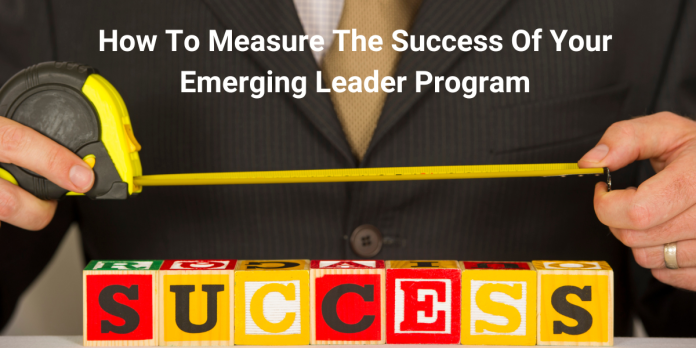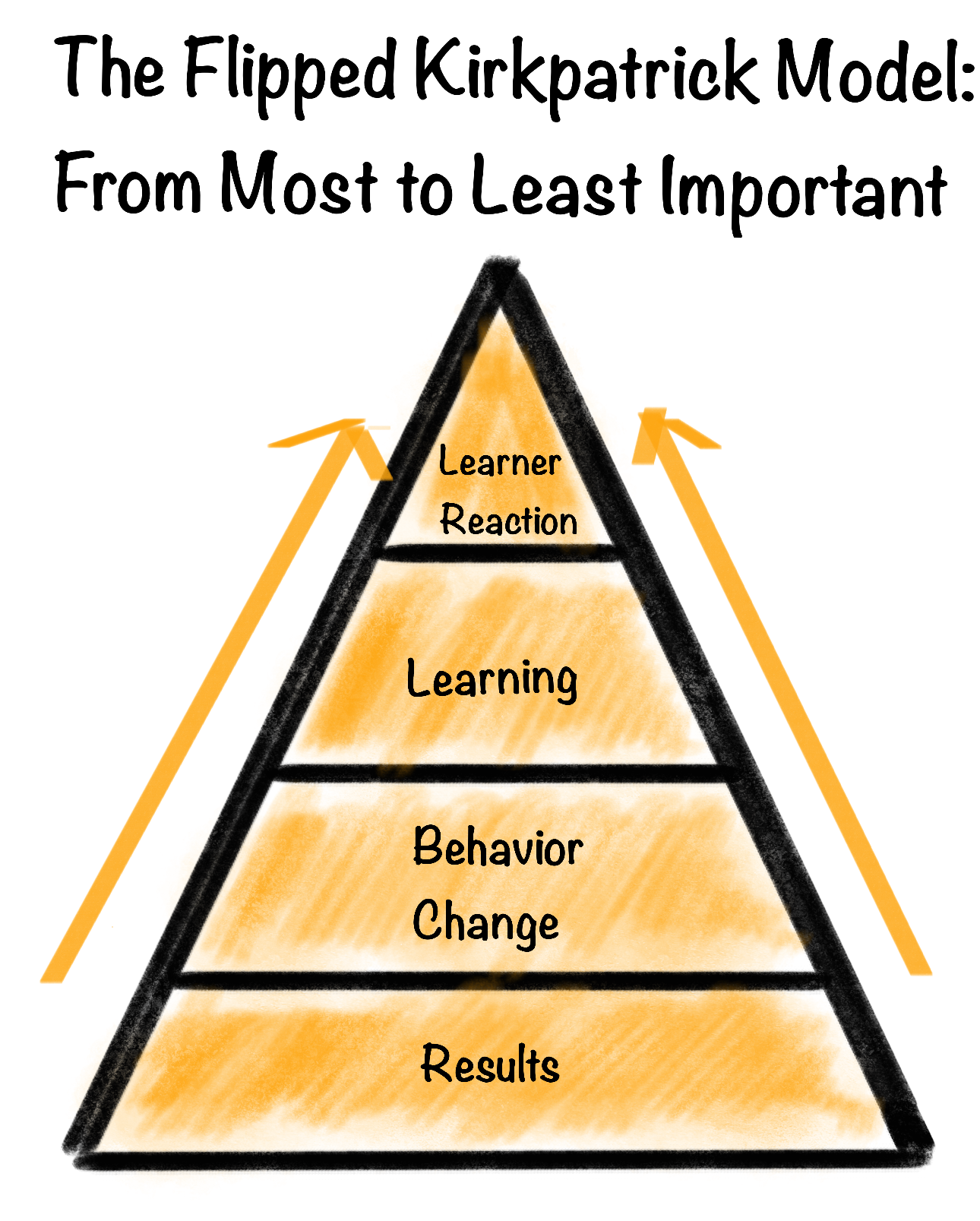
“Why would I want to measure my emerging leader program? It might show we aren’t making a difference!”
That was the very real response I got many years ago from the VP of L&D at Novartis when I asked her about her measurement strategy.
 And in recent weeks, here are the less evil but no less misguided answers I’ve received from different heads of leadership development:
And in recent weeks, here are the less evil but no less misguided answers I’ve received from different heads of leadership development:
- “I have no idea how to measure ROI.”
- “I don’t have enough budget to measure impact.”
- “Our CLO asks us to measure butts-in-seats and satisfaction. Those are the only two numbers he cares about.”
The funny thing about all of these points is that they point to the same way of thinking: “Measurement is an endpoint.” Measurement is a “cherry on top,” or if it goes poorly, “evidence of failure.” But what if I told you that measurement should be the foundation of your program?
A clear plan around measurement acts as your North Star. When you find yourself unsure of something (i.e., your participant selection or your curriculum design), your measurement plan will point you in the right direction.
With that in mind, this article will show you how to set an ROI-level goal for your emerging leader program and how to measure it. I’ll even show you how to do so with little to no budget.
Start by Flipping the Kirkpatrick Model
“Begin with the end in mind.” —Stephen Covey
All too often, the Kirkpatrick model lets leadership development down. Though not intentional, placing “Learner Reaction” at the base of the pyramid (Level 1) leads people to begin there and to see “Business Impact (Level 4)” as an afterthought or a nice-to-have. They think, for instance, “What topics can I choose that my emerging leaders will enjoy?” By flipping the model, you can begin with your Big Goal and work your way backward.

With a “business impact” goal as your foundation, a plan for measurement becomes much easier.
Here’s what I mean
A Journey Through the Flipped Kirkpatrick Model
Let’s go level by level through the Kirkpatrick Model (flipped) using three of the most common “business impact goals” for an emerging leader program.
1. First-line Leader Fast Track: To prepare individual contributors to take first-line leadership positions (fill in for first-line leader attrition). These are usually narrow programs for chosen, soon-to-be first-line leaders (typically a small, selective audience).
2. Engaging ICs: To engage and retain talented individual contributors (reduce turnover). These are typically broad programs to engage interested ICs (typically a large audience).
3. Exploring First-Line Leadership: A combination of 1&2. This usually combines the above goals. For instance, you might have a selective program that still lets in all of the top 15% of your talent. Instead of making it a leadership track program, you might make it a self-leadership program that offers a glimpse into what first-line leadership looks like (typically a medium-sized audience).
We’ll refer to each of these examples as:
- First-line Leader Fast Track
- Engaging IC’s
- Exploring First-Line Leadership
Okay, now let's dive in:
1. First-line Leader Fast Track:
Level 4 Example Goal: To replace at least 60% of first-line leaders who turn over or promote the year after your emerging leaders graduate.
Level 3 Example Goal: To show improvement across three critical leadership skills: Emotional intelligence, Confidence, and Growth Mindset. By improving in these three skills, emerging leaders should be well prepared to step into a leadership position.
Level 2 Example Goal: Require at least 80% completion across all exercises, assignments, and attendance at group coaching sessions to graduate. The idea here is to ensure emerging leaders get enough “reps” for learning to stick and for behavior to change (Level 3).
Level 1 Example Goal: Make sure at least 70% of our emerging leaders would recommend your program to a colleague. The idea here is to make sure that the content, examples, and delivery of each core leadership skill are engaging and motivating enough for learners to complete their work and accomplish the level 2 goal. This number does not need to be too high since “comfort” and “enjoyment” can often be at odds with “effective at changing behavior.”
2. Engaging IC’s:
Level 4 Example Goal: To improve turnover from 30% to 15%.
Level 3 Example Goal: To show improvement across three self-leadership skills that are closely tied to engagement: Emotional Intelligence, Stress Levels, and Resilience
Level 2 Example Goal: Issue at least 100 digital badges per year (requires 80% completion of all activities and attendance as well as extracurricular on-the-job exercises).
Level 1 Example Goal: Same as the first example.
3. Exploring First-Line Leadership:
Level 4 Example Goal: To improve turnover (same as #2) and to prepare ICs to step into leadership positions (same as #1).
Level 3 Example Goal: Same as #2 for turnover, plus same as #1 for critical leadership skills (blend these critical skills together in one program).
Level 2 Example Goal: Same as previous, plus completion of “leadership interest” activities. For example, emerging leaders may take a reflective self-assessment of “leadership interest” and shadow a current first-line leader.
Level 1 Example Goal: Same as the first example.
Additional examples of common emerging leader program goals include:
- To diversify and expand your pool of future leaders
- To create a culture of learning and leadership
- To show emerging talent what leadership looks like (to select for and eliminate prospective leaders)
You can see how beginning with level 4 measurement helps you decide what to measure at each level. But, how do you actually measure it?
How to Measure Your Goal: Level by Level
Let’s run through some examples of measuring each level of an emerging leader program. I’ll break down each example by cost:
Level 4 Example: Success of a “First-Line Fast Track” program
Free Way to Measure Success:
- Before: How many leadership positions will we likely need to fill over the next year?
- After: How many of those positions were successfully filled from your cohort?
Low-Medium Budget Way to Measure Success:
- Before: How prepared to lead is each emerging leader? You can measure this using a self-reflection exercise, an interview with their coach, and an interview with their manager.*
- After: All of the above are measured again and compared.*Note: Pricing on this depends on whether you’re building out questions and interviews in-house.
High Budget Way to Measure Success:
- Before: Measure the team engagement of your current new managers, who haven’t been through your emerging leader program.
- After: As emerging leaders go on to become new managers, measure their team engagement scores. Compare these scores to those of your untrained new managers.
Level 3 Example: Success of an “Engaging ICs” Program
Low Budget Way to Measure Success:
- Before: Give a self-assessment of key behaviors for EQ, Self-Awareness, and Growth Mindset.
- After: Give the same self-assessment and compare change over time.
Low-Medium Budget Way to Measure Success:
- Before: Give the participant and their manager an assessment of your emerging leaders’ key behaviors. Include an open comments section.
- After: Give the participant’s manager the same assessment. Include the same open comments section. Compare results.
High Budget Way to Measure Success
- Before: Emerging leaders take a 360 assessment of critical skills (i.e., EQ, Self-Awareness, and Growth Mindset). The emerging leader’s manager rates her, her peers rate her, and she rates herself.
- After: Emerging leaders retake the 360 assessment and compare scores.
Level 2 Example: Success of Any Program
Create a digital badge that hinges on a strong percentage of completion of learning, exercises, and activities. This helps drive toward behavior change by ensuring your leaders practice.
Level 1 Example: Success of Any Program
At LEADx, we typically ask a simple yes or no version of Net Promoter Score:
- “I would recommend this program to colleagues who want to improve their ______.” [Yes/No]
Focus Is Your Friend
I’ve noticed a funny trend in leadership development. Often, the most effective teams are the smaller, scrappier ones. And that’s no coincidence. With little budget and little room for error, they focus on one key goal and put everything they have into it. That mentality works—regardless of the size of your team or budget. When it comes to measurement, don’t try to do everything at once. Focus on that one business impact goal. Put together a plan to train and measure toward it. And you’re off to the races.
The good news is this: Simply by measuring Levels 3 and 4 you will be ahead of the rest of the leadership development world. OUr 2024 Benchmark report found that just 39% of leadership development professionals measure Level 3 and 22% measure level 4.






